America Recycles Day in Detroit, November 15th

NATALIE JAKUB, IS THE EXECUTIVE DIRECTOR FOR GREEN LIVING SCIENCE, AND A LEADERSHIP COMMITTEE MEMBER FOR SUSTAINABLE BUSINESS NETWORK DETROIT America Recycles Day held annually on November 15th holds immense importance as it serves as a powerful reminder of the critical role recycling plays in conserving resources, reducing waste, and protecting the environment. This annual observance encourages individuals, communities, and businesses to take concrete steps toward sustainability by pledging to recycle and promoting recycling education and initiatives. It reinforces the idea that recycling is not just a one-time effort but a continuous commitment to creating a greener, more sustainable future for generations to come. America Recycles Day inspires collective action and underscores that every small recycling act contributes to a significant positive impact on our planet. ENHANCING RESIDENTS’ ACCESS TO RECYCLING SERVICES For nearly two decades, Detroit has been proactively enhancing residents’ access to recycling services as part of its broader sustainability mission. Acknowledging the importance of diverting recyclable materials from landfills to minimize environmental impact and conserve resources, the city has implemented initiatives such as expanding curbside recycling pickup, improving access to public space recycling, and fostering partnerships with local organizations. These strategic moves aim to make recycling more accessible and convenient for Detroit’s residents, empowering the community to actively participate in sustainable practices and contribute to a cleaner, greener city for all. GREEN LIVING SCIENCE At the forefront of Detroit’s sustainability journey stands Green Living Science (GLS), a nonprofit organization dedicated to educating Detroit residents about waste and recycling. Initially established in response to the Detroit Public Schools Community District’s request for recycling and conservation education, GLS has grown to provide a range of educational programs aimed at instigating behavior change for a more sustainable society. SERVING RESIDENTS GLS serves Detroit’s 600,000+ residents who have been adversely impacted by the trash, air pollution, and debris pervading communities. The city launched a curbside recycling program in 2015 and contracted GLS to teach residents about recycling and sign them up for free recycling carts. GLS remains the recycling and outreach contractor for the Department of Public Works (DPW), educating residents about recycling services available to them and working closely with block clubs and community groups throughout the city. One of GLS’s flagship programs, the Bee Green Business initiative, launched in 2014 in response to the corporate sector’s need for effective recycling and waste reduction solutions. This program educates and certifies companies in Southeast Michigan committed to responsible corporate citizenship. By training businesses to establish waste reduction and recycling systems and educating their staff on correct usage, Bee Green Business supports companies in minimizing their environmental footprint. Moreover, it recognizes and celebrates businesses that are leading sustainability in Michigan. Southeast Michigan, with its historical legacy of manufacturing and innovation, has emerged as a vibrant hub for sustainability initiatives, embracing the principles of responsible business practices. GLS envisions a future for the region where sustainability is integral to business operations, and where companies prioritize environmental impact alongside financial success. To realize this vision, GLS focuses on reducing waste through recycling and composting advocacy, partnering with local businesses to ensure recyclable materials are diverted from landfills, thus reducing the environmental burden. CIRCULAR ECONOMY GLS champions sustainable sourcing practices, encouraging businesses to embrace the circular economy, which minimizes waste and maximizes resource efficiency. These initiatives help bolster the regional economy while diminishing the environmental repercussions of long-distance transportation. While Southeast Michigan has made significant headway in its sustainability journey, it grapples with challenges stemming from its industrial past, including pollution and environmental degradation. Nevertheless, GLS’s emphasis on circular economy principles and waste reduction contributes to overcoming these challenges and forging a cleaner, more sustainable city. Remediation and cleanup efforts continue to address these issues. We are seeing businesses adopting circular economy principles, minimizing waste, and maximizing resource efficiency which will help address and overcome the legacy not dedicated to creating a cleaner city. Green Living Science plays a pivotal role in Southeast Michigan’s path toward sustainability by serving as a catalyst for change. Through engagement with businesses, schools, and communities, GLS offers valuable resources and educational programs that empower individuals and organizations to embrace sustainable practices. In conclusion, Southeast Michigan stands as a burgeoning center for sustainable business practices and environmental responsibility. As Southeast Michigan confronts its sustainability challenges and strives to attain its goals, the role of GLS in educating, inspiring, and facilitating change cannot be overstated. Together, Southeast Michigan and GLS are forging a path toward a greener, more sustainable future, benefiting all who call this region home. Be sure to subscribe to our newsletter for regular updates on sustainable business practices in and around Detroit.
Historic Detroit Hotel is Renovated With Sustainability in Mind
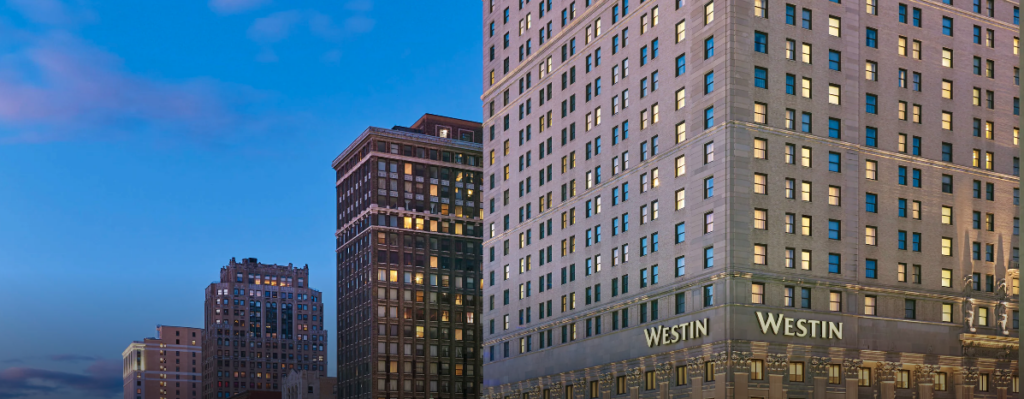
The Westin Book Cadillac Detroit, a historic 31-story hotel on Washington Boulevard, executed a $20 million makeover this year, and sustainability was part of the plan. The hotel first opened nearly a hundred years ago in 1924 and had several owners before closing in the 1980s. It was reopened in October 2008 after a $200 million restoration. It is managed by Marriott International. SBN Detroit spoke with Scott Stinebaugh, director of sales and marketing, The Westin Book Cadillac, to learn more about how sustainability has played a part in the renovation. Q: Talk to me a bit about your sustainability approach. A: For a long time, I think we were not doing as much as we could have been. And then we were hit with COVID and all things came to a grinding halt. As we started looking to renovate the building, that presented many opportunities to improve on what we had been doing. The hotel is just emerging from a $20 million renovation. Looking back to 2008 when we reopened after a full-scale $200 million restoration, we had state-of-the-art HVAC, water flow, and energy equipment at that time, and now fifteen years later, it’s time to improve the infrastructure and systems. And we’ve done that. Q: What are some examples you can point to? A: We’ve upgraded the 453 guest rooms and public areas to 100% LED lights. We replaced 1,500 four-foot fluorescent tubes with LED lighting, and 330 75-watt halogen bulbs have been converted. All of the guest rooms had individual heat pumps so that was a good start, but we upgraded the public area HVAC system to a system that has a sensor and uses outside air when the conditions are right to cool the building. Another part of the renovation was converting 75% of the tubs in the guest rooms to stand-up showers (which can save water). We donated as much of the furniture as we could to divert it from landfills. Habitat for Humanity took as much as possible, and the rest went to liquidators who used third parties to reuse the furniture. We now recycle all cardboard, bottles, and cans and have them picked up weekly. From a food waste standpoint, we work with Metro Food Rescue. We call them when we have extra untouched food and they come pick it up within an hour and distribute it to people in need. We are also working with Make Food Not Waste to get certified through their PLEDGE program focused on reducing wasted food. In meeting rooms, we now have water bubblers versus serving water in pitchers and we converted from plastic water bottles to box water. In line with our brand, Westin has a new initiative called The Well in which guests can get complimentary water in the lobby and refill the throughout their stay. We sell glass bottles that guests can use also. We are among the first Westin hotels to launch this. Q: Do your guests ask about your sustainability practices? A: Yes. We get a lot of questions about our sustainability practices. We know this is part of the decision-making when people are choosing venues for events. It’s happening more and more, which I think is great. Q: What are the biggest challenges? A: Being consistent. Sometimes we get so busy in an operation like this. We are a $40 million annual revenue entity, and the work can seem endless. It’s about not getting lazy and staying consistent. Because it’s easier to throw that piece of waste in a place where it does not belong versus recycling. It’s easier to throw food away versus calling for a pickup. It takes focus, time, and accountability and that, I think, is our biggest challenge. Q: How do you keep staff accountable? A: We have weekly goals in every department that we call WIG (Wildly Important Goals). These are important goals that we put into a measuring platform every week, and sustainability goals are a part of this. There are small and large things in each department that, combined, make a difference. Q: What are the biggest opportunities? A: I think there are more things we can do in all areas of the hotel and also the ongoing education of the staff. Making sure when staff turns over that our sustainability commitment and practices are ingrained in new employees so that our efforts are not weakened or broken is critical. It’s important to keep that fire going. Q: Do you find your staff to be enthusiastic about the sustainability efforts? A: Yes. I think they are excited about making a difference. I see it in the commitment they have to follow and work through the processes that are in place. And the overall commitment here comes from the top down as well. Q: How do you think your efforts might influence businesses in Southeast Michigan? A: We all need to be good corporate citizens and responsible to the earth. I think when others witness our efforts and the efforts of those around them, that can be contagious. I hope so. Q: What are you most proud of when it comes to the practices you’ve implemented? A: The metro food rescue. I’m a day one employee in this hotel. Over the years, I’ve seen a lot of food waste. Food that is untouched going into the trash. Putting a stop to that and being able to give perfectly good foot to those in need is huge. And imagine if everyone did that. Be sure to subscribe to our newsletter for regular updates on sustainable business practices in and around Detroit.
Implementing Sustainability Initiatives is Crucial in Today’s Business World
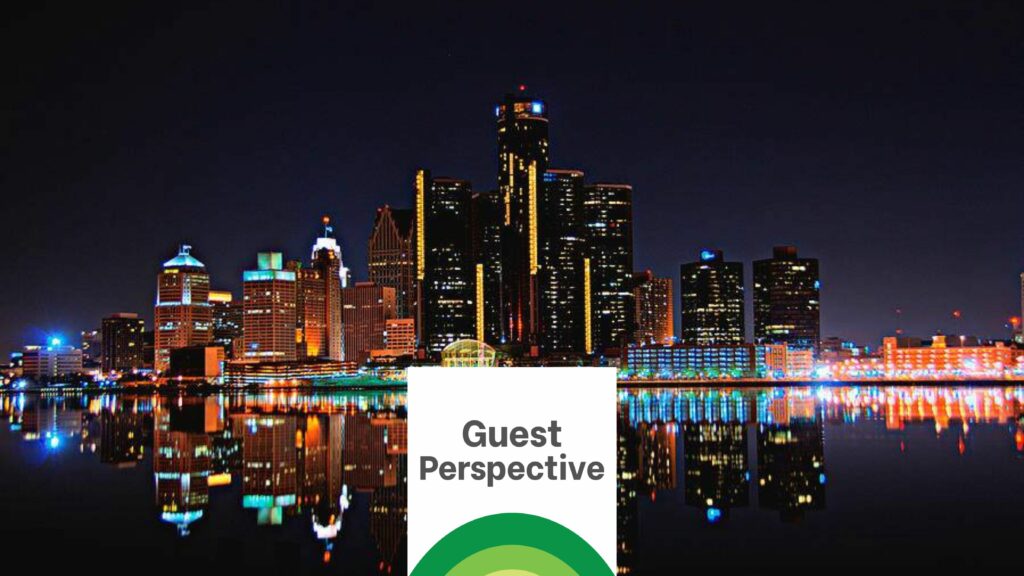
CONNIE LILLEY IS THE EXECUTIVE DIRECTOR OF DETROIT 2030 DISTRICT You may be missing out on growth opportunities if you’re a business that has yet to jump on the sustainability train. I’m sure you’ve heard the word “sustainability” before, but what exactly does that mean to your business? That’s the question all individual companies need to ask. PEOPLE, PLANET, AND PROFIT The well-known triple-bottom-line theory is just one of many theories floating around today. But, the most basic question that all businesses need to ask is: How is my company benefiting People, Planet, and Profit? No matter what program, theory, or process a business intends to follow, there’s one sure thing – getting started can be the hardest part. But, if you are a company that is just getting started, it’s easier than ever to create a sustainability plan for a business. Companies no longer have to reinvent the wheel when writing a sustainability plan. Other businesses have created many programs and published sustainability plans to help lead the way and share best practices. While sustainability means different things to different organizations, there’s no denying that implementing sustainability initiatives can help a company’s growth in more ways than just environmental stewardship. While that is the main focus of sustainability, let’s not forget about the economic benefits as well. A company that reduces utility costs can put that savings into hiring more employees, spurring economic development. Sustainability plans should be a part of any business operational plans. Here are some of the benefits of getting started. SAVE MONEY ● Reduce the cost of transportation to and from landfills ● Reduce your operating expenses when you use less energy and water ● Reduce your stormwater runoff fees Reduce your company’s carbon footprint ● Lowering greenhouse gas emissions by reducing energy and water consumption ● Installing gardens or green roofs to manage stormwater runoff ● Reduce transportation emissions to and from landfills and local traffic Increase your revenue: ● Increase positive public relations and marketing by promoting your company’s sustainability efforts ● Increase sales by offering sustainable products to your customers ● Create a healthy building to attract quality tenants to increase rent ● Provide a healthy environment for employees and thereby reduce sick days The steps described above are not always easy to implement. If you own or manage a building, creating a high-performance building takes focus and commitment. Organizations such as 2030 Districts are forming across North America to assist facility managers and owners with tasks such as tracking and managing water and energy consumption, offering educational opportunities, sharing best practices, and more. Most 2030 District programs are free or cost-effective compared to hiring a consultant or company to assist. For more information and to find a 2030 District in your city, visit www.2030districts.org. Be sure to subscribe to our newsletter for regular updates on sustainable business practices in and around Detroit.
Small Business Role in Sustainability is Largely Untapped
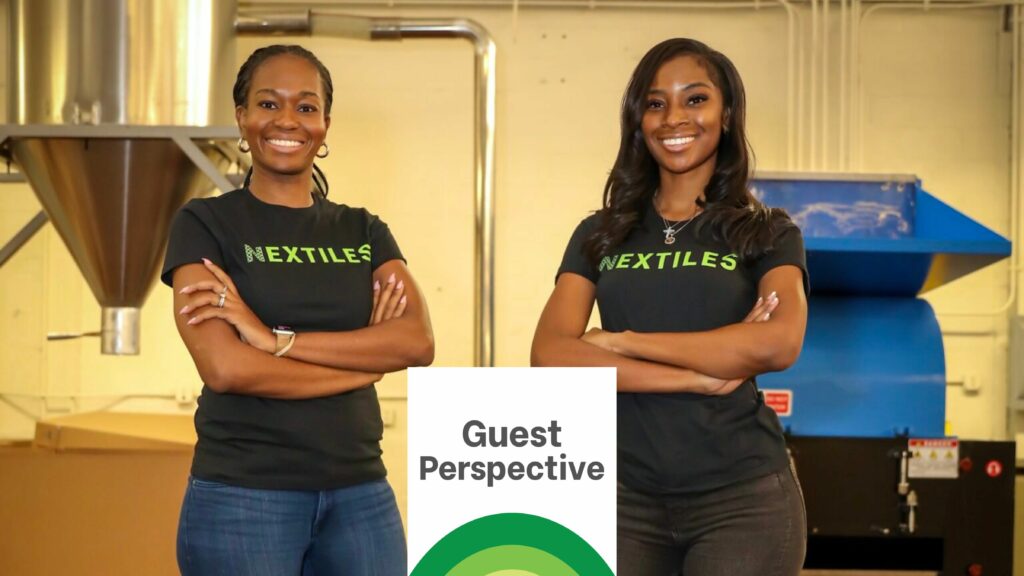
WAFA DINARO, EXECUTIVE DIRECTOR, OF THE NEW ECONOMY INITIATIVE, AND A LEADERSHIP COMMITTEE MEMBER FOR SUSTAINABLE BUSINESS NETWORK DETROIT During an internship with a recycler in New York in 2020, entrepreneur and environmental scientist Madeline Miller watched as the waste materials from textile companies were being processed in the facility, and something entrepreneurial clicked. In the “waste,” she saw home-building insulation that could be reused back home in Michigan while increasing energy efficiency in Detroit homes. From there, NexTiles was born, a Detroit-based textile recycling company that produces EcoBlow – a nontoxic, eco-friendly building insulation made entirely of recycled pre-consumer fabric from manufacturers, particularly automotive interior suppliers, and fashion designers. While her experience reflects the role small businesses can play directly in terms of creating eco-conscious products, every small business, no matter their product or service, can implement eco-friendly business practices. Unfortunately, many of the same challenges that prevent small businesses from thriving in general – limited access to capital and lending; a lack of technical assistance in finances, marketing, and business planning; and the inability to tap into a business support network for grants and resources – will prevent them from reaching their full potential in sustainability. Yet, nearly all the factors that help small businesses drive economic resilience position them to be a transformative force in sustainability. SMALL BUSINESS DRIVES SUSTAINABLE ECONOMIC RESILIENCE First, there are the sheer numbers. There are 33.2 million small businesses in the U.S. accounting for 99.9% of all businesses. They make up our largest employer group and accounted for almost two-thirds – or 17.3 million – of all jobs created from 1995 to 2021, according to the Small Business Administration. And they continue to grow, in 2022, there were more than 5.1 million new business applications filed. Second, small businesses are nimble and can move quickly to drive innovation. They are fueled by their founders’ ideas and life experiences and are often created to provide solutions to real-world problems impacting friends, families, or communities. Third, small businesses are invested in the social fabric of their communities and exist all around us, giving them nearly universal reach. They have a vested interest in their neighborhoods thriving that stretches well beyond business and adds further incentive for them to succeed. At the New Economy Initiative, we’ve spent the past two decades building a support ecosystem that helps entrepreneurs, startups, and small businesses build a more resilient economy within their own communities and Southeast Michigan. In the case of NexTiles, we provide funding to the Centrepolis Accelerator at Lawrence Tech University, which has played an integral role in NexTiles’ product development and growth. It is why we support similar nonprofit and locally grounded organizations that provide technical assistance, lending, and connections to small businesses throughout Southeast Michigan. Sustainability is the next logical step in expanding our mission. That is why the New Economy Initiative is pursuing a sustainability program to integrate with our traditional business support activities. NEI SUSTAINABILITY PROGRAM GOALS That program can accomplish a few major goals that will help small business play its role in sustainability by mirroring much of what we already do. It would include raising awareness about the bottom-line business benefits of sustainability that can be achieved through energy efficiency. It can help businesses identify how to integrate sustainable practices into their business plans that reduce waste while increasing efficiency and profits. It can help them access resources and grants available to increase sustainability. Chief sustainability officer is one more a hat small business owners are asked to wear – we need to provide a small business ecosystem that empowers them to fulfill it. Until we do, the collective power of our largest employer group to create a world that lasts for future generations is largely going untapped. Source for data: https://www.uschamber.com/small-business/state-of-small-business-now Be sure to subscribe to our newsletter for regular updates on sustainable business practices in and around Detroit.
A Social Investment Model Designed to Give Power to Residents and Local Businesses
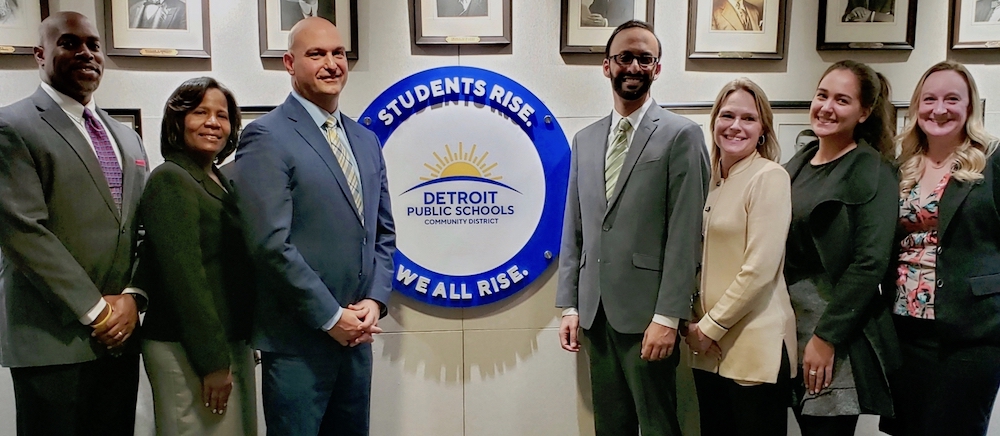
Rishi Moudgil leads the GreenLight Fund of Detroit, a locally driven, cross-sector, community-centered model to collectively identify critical paths to prosperity and invest in equitable social impact programs for children and families facing economic barriers in Detroit. SBN Detroit spoke to Moudgil about the model, sustainability, and impact on Detroit residents, businesses, and stakeholders. Q: Tell us about GreenLight Fund – what is the impetus behind it? A: We are focused on tackling poverty and its effects on residents by investing in solutions that complement the local landscape and boost the existing ecosystem with a proven model that has had a track record in other urban areas. We believe that for a social impact model to succeed and scale it must be aligned directly with who it serves and therefore local folks must drive the process of both determining their needs and selecting the ventures we invest in. It comes back to the challenge of pushing into a community versus being pulled. Our unique model is pull-through. We organize the stakeholders and local advocates to ensure that only programs that align with their needs and have high quality are brought in. Q: What are examples of programs you’ve invested in and the outcomes? A: A workforce program example is the Center for Employment Opportunities. We launched this in Detroit, and it offers immediate and comprehensive employment options for those who have been incarcerated. It’s a multistage model that helps folks to gain immediate employment and put them on a path for long-term work. This dramatically reduces the human cost and financial costs of returning to the justice system. They also partner with existing organizations to shift policy measures that benefit thousands of residents to stabilize their lives and gain employment. Another workforce program is the New Teacher Center, which provides new instructors with embedded support to enhance teaching practice and retention. This builds sustainability within their jobs and student learning gains in the classroom. The program has trained over 150 veteran teachers who mentor new teachers with evidence-based support and it’s reducing the turnover rate in the Detroit Public Schools community district. These programs each came by a community-led process where local residents helped determine the gaps in their communities. We also then hire Detroiters to run the new programs. Q: Relating it to sustainability and businesses in Southeast Michigan – what role does economic sustainability play in your investment strategy in Detroit? A: The key foundation for people to prosper is a combination of economic stability and to have opportunities to advance. Workforce opportunities are critical, and in a place that has been plagued by disinvestment for so long, workforce and economic programs are not enough. We need to wrap around human services transit, housing, education, and more. There are so many topics related to creating an economic foundation for individuals and businesses. Q: What role does environmental sustainability play? A: We can’t have stable places to live, work and play unless the environment is stable. And low-income neighborhoods are some of the most environmentally unsound areas, so this exacerbates a host of problems that continues the cycle of poverty. But where development occurs, home ownership will follow, and thus begins the process of building a more sustainable community. Q: Your website says, ‘Our deep connection with the community and strategic partnerships help organizations ramp up and start producing direct, meaningful change. This ongoing support enables organizations to thrive over time.’ How does this work? A: What we are doing is shifting an approach of social investing to both trusting residents directly and developing stronger outcomes. We rely on residents to choose their destinies. We raise unrestricted capital from partners around the city and hand the funding decisions back to local stakeholders. Deep and ongoing trust is the key ingredient toward achieving the best outcomes. After we launch, we hold a seat on their board, shepherd additional partners and resources, and help create a path of success. Q: How do you account for ROI in your investments? A: We are completely focused on social ROI, as are all of our social investment recipients. We co-develop social impact metrics with both our communities and organizations before we begin operations so there is a clear set of performance outcomes we all agree on. Each organization has a set of outcomes that we all pull together toward achieving, and we know that if these goals are achieved then we are achieving the goals desired by our stakeholders. Q: What’s the largest hurdle you face? A: The biggest challenge is the people and families that have been in some of our neighborhoods the longest have received a disproportionate brunt of the disinvestment. There is no silver bullet. Multiple efforts need to be tackled over the long term. We have to be honest about how we all got here and have difficult conversations about race and gender and inequality. So, one of the largest hurdles is alignment. Are the solutions properly aligned to the true needs of the people and planet and are they sustainable to create lasting change over time. Q: How do you see the city’s Sustainability Action Agenda aligning with the work you are doing? A: We are completely aligned with the agenda and believe we need integrated action. This means centering people and the planet simultaneously. We can no longer isolate variables and expect progress. Sustainability and social impact goals must be front and center as we build toward the future. Be sure to subscribe to our newsletter for regular updates on sustainable business practices in and around Detroit.
Michigan Green Communities is Moving Community Sustainability Initiatives Forward
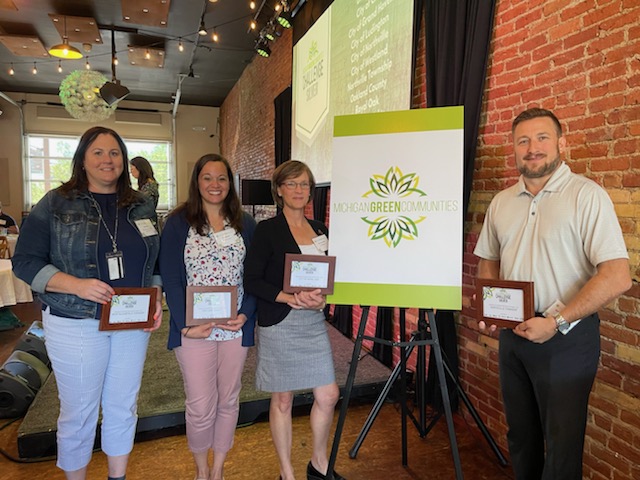
Established in 2009, Michigan Green Communities (MGC) is a statewide sustainability assistance program that works to embed sustainability into municipal and county operations. MGC is a collaboration and partnership of the Michigan Economic Development Corporation (MEDC); the Michigan Department of Environment, Great Lakes, and Energy (EGLE); the Michigan Department of Health and Human Services (MDHHS); Michigan Department of Transportation (MDOT); the Michigan Department of Natural Resources (MDNR); the Michigan Association of Counties (MAC); the Michigan Municipal League (MML); and the Michigan Townships Association (MTA). It is led by a 15-member steering committee from the partners and local governments, including West Bloomfield Township, Ann Arbor, and Canton Township. SBN Detroit spoke to Danielle Beard, Michigan Green Communities coordinator, to find out more about the work it is doing to impact sustainability initiatives in Southeast Michigan and throughout the state. Q: What is Michigan Green Communities? A: Michigan Green Communities (MGC) is a sustainability benchmarking, networking, and technical assistance program for municipalities and counties in Michigan. The goal is to embed sustainability in local government operations and promote innovative solutions at the local, regional, and state level. The main component of the program is the annual MGC Challenge (that’s the benchmarking piece) where communities track in their online accounts whether they’ve completed or are in progress on a set of action items and log metrics (click here for the full list of action items and metrics). Communities that participate in the MGC Challenge have access to free support and technical assistance programs through the MGC program and EGLE’s Catalyst Communities program. Q: What is the impetus behind MGC? A: There are a lot of benefits to embedding sustainability into municipal and county operations. Cost savings is a big driver for communities as they can slash their energy and water bills, helping them control the cost of their operations. Additionally, Michigan’s weather patterns are changing drastically, and local units of government play a large role in adapting our society to these changes. Local policies and decisions can help to mitigate the effects of heat waves, severe snowstorms, massive rain events, and more. Multiple state agencies interact with communities on different areas of sustainability. The MGC program was designed to bring those agencies together to collaborate on how to best meet the needs of local governments. And because local governments are also on the steering committee, they’re providing feedback to state agencies on the challenges they face to inform the agencies’ work. Q: What areas of sustainability are you focused on? A: The Michigan Green Communities program focuses on embedding sustainability into local government policies, programs, and operations. The MGC Challenge action item categories outline this best: Planning for Inclusive and Lasting Impacts Climate Resilience and Adaptation Energy Efficiency & Renewable Energy Responsibly Managing Materials Sustainable Land Use & Economic Development Improving Health Outcomes Protecting & Conserving Water Resources Support Clean & Inclusive Mobility Inspire & Mobilize Residents Q: What examples can you give of the work that’s been done? A: Since it was started in 2009, over 100 communities have participated in various ways and taken steps to advance sustainability in their communities. In our 2021 challenge: 45 communities participated representing 3.6 million Michiganders. MGC awarded 12 bronze certifications, 10 silver certifications, and 23 gold certifications. Over 1,500 sustainability actions were logged as complete, and over 1,000 were logged as in progress. The MGC Challenge added a set of metrics to track data like GHG (greenhouse gas) emissions, community water use, and more. We launched the MGC Accelerator Cohort to advance sustainability practices in bronze & silver MGC Challenge communities. The current challenge is now live, and communities can report on their sustainability actions through the 2023 calendar year. Q: What does the future look like for MGC? A: In short, the future of MGC will involve bringing more technical assistance, resources, and templates to communities to help them expedite resiliency strategies and decarbonize their operations. This will also involve more networking among communities so they can learn from one another and not reinvent the wheel. We launched the MGC Accelerator Cohort in January 2023, which is a group of bronze and silver-certified MGC Challenge communities that come together as a group to address sustainability issues. The first topic that we’re focusing on is green infrastructure. Many communities in Michigan have been dealing with flooding and water runoff causing pollution, fluctuating shoreline water levels, and severe weather events. Green infrastructure solutions can help to address these issues in a way that protects man-made infrastructure and natural features. The group will meet monthly with subject matter experts and consultants that MGC has hired to share ideas, draft ordinance language, and identify potential implementation opportunities and funding for green infrastructure projects. After the green infrastructure module, the cohort will select another topic to work on in a similar style. The cohort is open to any community that has taken the previous Michigan Green Communities Challenge or plans to participate in the current Michigan Green Communities Challenge. This work is being funded by the MEDC. Be sure to subscribe to our newsletter for regular updates on sustainable business practices in and around Detroit.
Cumulus Holds Global Design for Adaptation Conference in Detroit
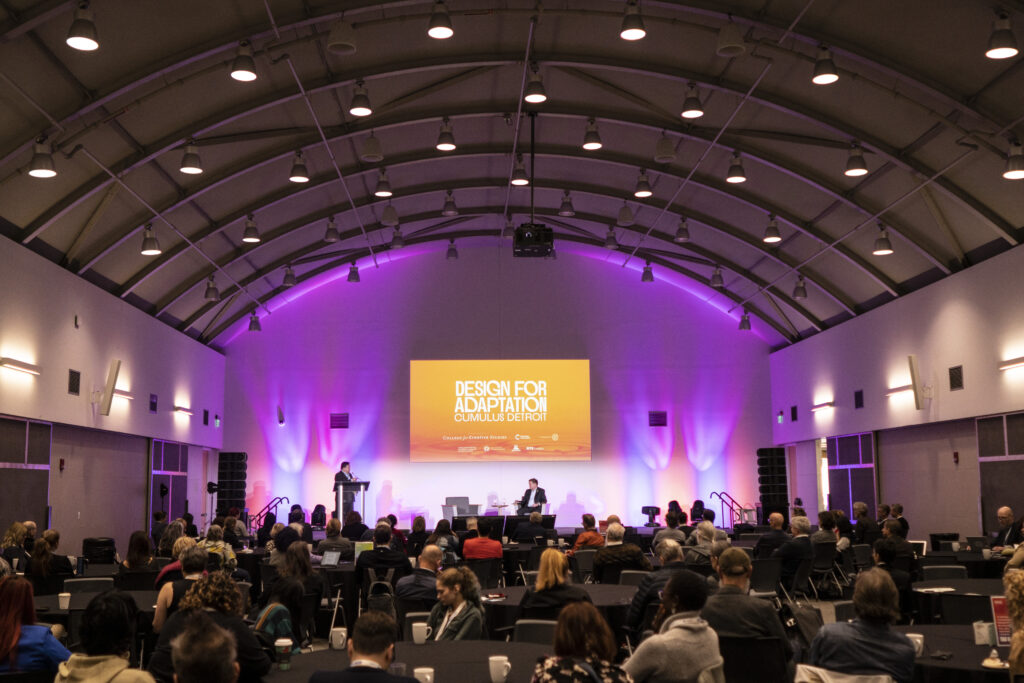
Cumulus, a global association of art and design education and research, held its annual conference, Design for Adaptation in Detroit Nov. 1-4 at the College for Creative Studies. This marks only the second time in its 30-year history that the conference was in North America. Cumulus connects 350 member institutions across 63 countries to exchange knowledge and best practices to elevate the positive role of designers and artists in creating sustainable and humane futures for all. “If there is one thing we know, we are stronger together,” said Terry Barclay, SBN Detroit Chair and CEO of Inforum, in a Thursday afternoon welcome address. “I think we have a common sense of urgency to break down silos that slow collaboration and this conference is certainly about that.” SBN Detroit was a conference sponsor. “This international conference has such diverse participation,” said Neil Hawkins, president of the Fred A. and Barbara M. Erb Family Foundation, who moderated a keynote address. We have creative designers hoping to change the trajectory of climate disasters. We have local Detroit leaders demanding justice for people already suffering impacts. We have great minds from all corners of the earth here in Detroit, which in many ways can be called ground zero for the climate crisis.” To that end, he noted that metro Detroit has endured serious local flooding from three 500-year rainfalls in the last ten years, holds 25% of the world’s surface freshwater in the great lakes, and the state is fittingly named after a natural resource – Michigan meaning “big lake.” Ian Lambert, co-chair and submissions chair for Cumulus 2022 and also dean of graduate studies at the College for Creative Studies, said, “As the only UNESCO-designated city of design in the U.S., Detroit has an incredible history of makers and manufacturing and design, so it’s fitting that Cumulus was held here. And it’s huge for Detroit.” The conference – focusing largely on the issue of climate change, automation, and income inequality – explored the role designers play in fostering adaptation through a wide range of approaches, methods, visions, and experiments. In that vein, the mission is to think ahead to catalyze ideas to reduce vulnerabilities and foster resilience for communities. Noting that the world is 1.2 degrees Celsius warmer than at any point in human civilization and that 300 billion tons of carbon have been added to the atmosphere by humans, keynote speaker Mikko Ollikainen, head of the Adaptation Fund, said to the audience of designers, “You are the minds to shape the future and you have your work cut out for you. … “We are facing an increasing arrival of uncertainty and must be prepared for things we do not expect and prepared to withstand shocks.” Land use and its relationship to climate change and inequity were the focus of several panels. Anika Goss, CEO of Detroit Future City, said in her keynote, “When we look at the cities in Detroit and around the world that are hit hardest by climate change, it’s always the poorest and the brownest neighborhoods.” She pointed to a community on the lower east side that suffered stormwater flooding as an example, saying, “From an economic standpoint these families continue to lose value in their homes and property simply because they live in a neighborhood with poor infrastructure.” The Eastside Community Network is working to put residents in charge of enhancing their neighborhoods toward resiliency. President Donna Given referenced its LEAP Sustainability Fellowship saying, “When you give someone a small amount of money and the responsibility to build a better space it’s amazing what that can do to a neighborhood.” The fellowship is a training and development program where fellows develop community projects, apply for grant funds to support them, and then implement them with the help of the community. To that end, Jerry Hebron, executive director of Oakland Avenue Urban Farm, shared her story of growing up near Motown in its heyday, leaving the city, and then returning in 2005 to find it riddled by crime and decayed. She became an activist and was charged to find out what needs the community had. “I knocked on doors to collect information and found that housing and food were the residents’ most important needs.” The high vacancy rate and open land equaled opportunity. The community wanted a garden and they built one – 20×20 feet. Today, 14 years later, they are farming 3.5 acres, a farmers market, youth programming, and more. “The community reclaimed that land and worked together to change their neighborhood.” Linking this back to design, Lambert and Leslie Tom, chief sustainability officer at the Charles H. Wright Museum of African American History, presented a collaboration involving the repurposing of three dying trees on the museum’s property. Instead of letting the trees end up in a landfill, The Wright and the Center for Creative Studies repurposed the trees and created a curriculum around co-design for sustainability, climate justice, and African American material culture, out of which came a narrative around how two neighbors – a museum and an art school – set a precedent for climate justice art. “One of the pieces a student created spoke to land use in Detroit by combining window panels from an abandoned home and the repurposed timber to tell the story of decay and rebuild,” Lambert said. There is no doubt that the complex consequences of climate change have pushed the need for community resilient strategies to emerge and thrive in the face of change. About the role designers play in this, Ollikainen said, “How designers see the world and work has a profound impact on building sustainable solutions. You have the vision, and you have the skills to turn that vision into reality.” Be sure to subscribe to our newsletter for regular updates on sustainable business practices in and around Detroit.
How Does Meijer, One of the U.S.’s Largest Private Companies, Approach Sustainability?
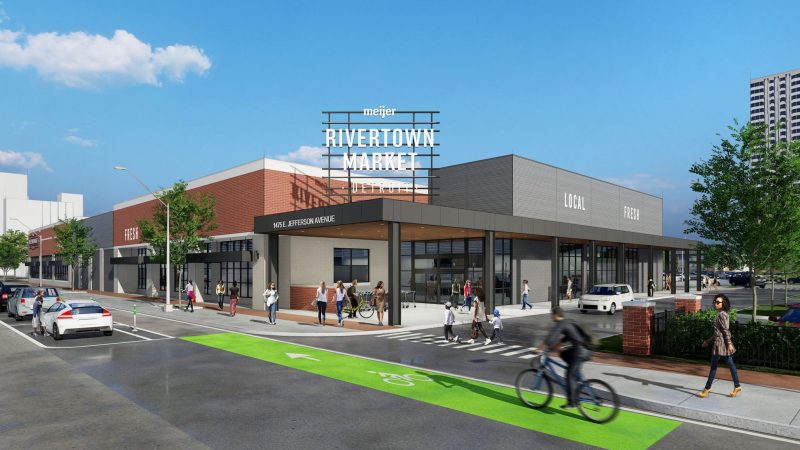
SBN Detroit interviews Erik Petrovskis, Director of Environmental Compliance and Sustainability for Meijer, the Michigan-based retailer with more than 250 stores and 70,000 employees in six states throughout the Midwest. The company ranks 13th on Forbes’ 2021 Largest Private Companies list. Petrovskis leads environmental management across Meijer, including remediation, due diligence, and multimedia compliance programs, and represents the company’s position on regulatory matters. Here he shares some of the efforts, challenges, and goals that are in place, and the opening of the Q: Meijer has a goal of reducing 50% of absolute carbon emissions by 2025 – Can you elaborate and share what actionable items you are working on toward that? A: Meijer set a goal to reduce our absolute carbon emissions by 50 percent by 2025. This reduction represents the emissions over which Meijer has operational control and includes things like our fuel, electricity, natural gas, and refrigerant usage. We have many ongoing projects to reach the reduction goal, including energy efficiency improvements, refrigerant leak detection systems, and fuel efficiency strategies for our fleet. Our virtual power purchase agreements (VPPAs) for two renewable energy fields will also support reaching a 50 percent reduction. Q: Tell us about Meijer’s investment in the Texas-based Lacy Creek Wind Energy Center and how it pertains to Meijer’s carbon emission reduction goals. A: Our investment is structured as a virtual power purchase agreement (VPPA). In this agreement, Meijer commits to purchasing much of the energy generated from the wind farm and receives renewable energy credits (RECs). This project is coupled with the Pisgah Ridge Solar project, which utilizes the same type of agreement. The RECs certify our purchase of renewable energy and therefore represent a reduction in overall carbon emissions from the energy we purchase. Q: When did Meijer initiate sustainability practices? A: Meijer was an early adopter of green initiatives. Fred Meijer, who led the company for more than 40 years, vowed to “Leave the world in a little better shape than when I entered it.” In fact, Fred Meijer spoke at the first Grand Rapids Earth Day celebration in 1970, and company-wide recycling, energy, and waste reduction programs were in place by 1973. Since then, we’ve undertaken many sustainability-related projects, like our plastic bag recycling drop-off, installing EV chargers at select stores, and sourcing responsible seafood. Among others, these efforts became formalized when Meijer established its first sustainability plan in 2014. At Meijer, we understand that to be a good company, we must be a good neighbor. We integrate environmental sustainability into our daily operations, not only because it makes good business sense, but because it aligns with our values and mission of enriching lives in the communities we serve. Our sustainability program has evolved to prioritize four pillars: carbon emissions reduction, food waste reduction, circular economy, and Great Lakes Stewardship. Q: Regarding the Detroit Rivertown location in Lafayette Park, what community partnerships have been put in place since opening? A: Since the store opened in 2021, Meijer has supported more than 20 community organizations, including Junior Achievement of Southeastern Michigan, Bees in the D, The Better Detroit Youth Movement, Pure Heart Foundation, and Greening of Detroit. Q: Are there any other sustainability efforts that are unique to the Rivertown location? A: The Rivertown Market includes electric vehicle charging as an amenity to our customers. This is part of our greater network of EV chargers, which includes more than 70 stores in our footprint. Rivertown Market will also participate in our Gutter Bin pilot program, which is part of our Great Lakes Stewardship efforts. The Gutter Bins will catch garbage and other debris from our parking lots before it enters the waterways. The Council for the Great Lakes Region will coordinate metric tracking and evaluation of the initiative, which is occurring across nine Meijer stores. Q: How does this location and Meijer overall deal with food waste? A: Meijer aims to keep food waste out of landfills. This begins with our ordering process, in which we optimize the quantities ordered to reduce overstock. However, we also have partnered with several organizations to find other solutions. For example, we work with Feeding America, and their network of food banks across our footprint, on our Food Rescue program to provide food nearing its sell-by date to those in need. In 2021, we donated 13.7 million pounds of food through this program. We also rolled out Flashfood program, which acts as a virtual clearance rack for food nearing its sell-by date. This program is not currently available at Rivertown Market but has already diverted more than 1 million pounds of food from potentially entering landfills. Also, any food that can no longer be consumed, including things like food scraps and rotten produce, is picked up from our stores, distribution centers, and manufacturing facilities by third-party vendors, who process the waste into animal feed and compost. Q: What are your biggest challenges when it comes to reaching your sustainability goals? A: We’re lucky to have had strong support both internally and externally regarding our sustainability goals. However, one initial challenge with ours was leading a cohesive path forward. The formation of our Sustainability Council united the company and allowed sustainability to move out across all functions of the business. The Sustainability Council, which is made up of representatives from across the company’s business areas, has served as a powerful mechanism in moving our efforts forward and achieving goals with strong cross-functional collaboration. Q: From your perspective, what is the role of businesses in Detroit in terms of sustainability overall for the city? A: Business plays a key role in sustainability on a global scale. Specifically in Detroit, a focus on business sustainability is essential for the city’s renaissance to be successful and enduring. Meijer is grateful to have the opportunity to support the city’s revival, taking both environmental and social sustainability into account. Q: What businesses and partners and vendors are you working with in Detroit who are doing it well? A: Meijer features
Tracy Reese Returns to Detroit to Train Local Craftsmen and Produce For a Global Sustainable Footprint
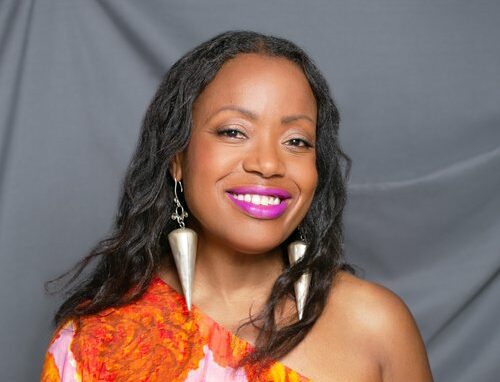
SBN Detroit spoke with Tracy Reese, an American fashion designer who has been featured in fashion publications that include Vogue, Elle, Glamour, InStyle, and O, The Oprah Magazine; and whose creations have been worn by Michelle Obama, Sarah Jessica Parker, and Taylor Swift. In 2018, after 30 years in the industry, Reese moved back to her hometown of Detroit and in 2019 launched Hope for Flowers by Tracy Reese. The collection is designed and produced following three guiding principles of sustainability: the health of people, the planet, and equity in profit. Reese serves on the board of directors of the Council of Fashion Designers of America (CFDA), where she has been a member since 1990. Reese also serves on the board of trustees of Nest Artisan Guild and the advisory council of the College for Creative Studies Fashion Accessories Design Program. She is also part of Turnaround Arts, a Kennedy Center program that transforms schools through the strategic use of arts. She recently served as board president of ISAIC, the Industrial Sewing and Innovation Center. She is working to build an artisan studio in Detroit creating economic opportunities for women in underserved communities. Q: Please share how Hope for Flowers and the sustainability aspect came about.A: In 2017, I had three labels and had been working in the industry for more than 30 years with my own brand, functioning as a typical manufacturing wholesaler. All of my production was overseas, and I sourced fabrics from all over the world. I started learning more about sustainability, and around that time, the CFDA + Lexus Fashion* Initiative that focuses on sustainability launched. I missed the deadline to apply in 2017 and was determined to apply the following year, so I did, and I was selected. It was an eye-opener. It was nine months of learning about everything from textiles to carbon footprint to human rights issues within the supply chain to waste in pattern making and more. At the end of the program, we were required to present a blueprint to be judged, and then to follow through with the blueprint. During this time, I started feeling a pull back toward Detroit and bought a house. I was trying to determine how I could be back in the city more. As I created this blueprint, I realized that Detroit was the perfect place to launch a brand. I started changing my perspective on how I was working. Running parallel to this was an impending departure of ways with my partners. There were things we didn’t see eye to eye on that were nonnegotiables for me. They wanted to go for volume, and I wanted to do something smaller and more meaningful and work on giving back to the community. So, I took the blueprint and headed to Detroit. Part of my blueprint included localized production, so training Detroiters to be part of this industry in a meaningful way was a natural next step. I set up a business model with a social and sustainability-focused mission. I worked with Shayla Johnson from Scarlet Crane Creations and interns from Cass Tech, my alma mater. We manufactured in Flint. This set the groundwork for Hope for Flowers. Q: Do you have a set of short-term and longer-term goals you are working toward as you grow Hope for Flowers? A: My short-term goal was and is to address the low-hanging fruit – textiles. Every product we work with falls into the mild zone. We are using bast fibers like linen – a crop that doesn’t require lots of water and doesn’t deplete the earth of nutrients. We also use organic cotton and responsibly forested wood byproduct fibers like Tencel and are experimenting with recycled wool and other fabrics. The idea is to create garments that stand the test of time yet biodegrade over the long haul. We look at biodegradable materials for buttons like natural shells or wood and try to use natural things found on the planet versus man-made We also try to design clothes that are flexible, meaning two different sizes can wear the same garment. This reduces overproduction My long-term goal is to produce in Detroit. To that end, we are training and working with local craftspeople and sewers to develop them to a stage of mastery that’s competitive with what we can import. We are launching an apprenticeship program, and our goal is to start running small-batch production in-house. Q: What impact do you think Hope for Flowers and the vendors and partners you work with are having? A: Each one of us is proving it’s possible, and I think that makes an impression on anyone considering taking steps toward sustainability. When those in doubt see a successful business model that’s working and financially viable, that’s impactful. The more people who choose to work this way, the easier and less expensive it becomes, and we can speak collectively. We need everybody to get on board, so it’s about setting aside the competitive mindset and working as a unified industry. Q: What drives your passion when it comes to the brand and its deep commitment to sustainability? A: I don’t see that it’s a choice really – it’s a necessity. We need to work in a way that’s less harmful to the planet and people. It’s also about holding ourselves to a higher standard, accepting the challenge and being energized by it. The idea of trying to solve this is exciting and I want to be up for the challenge, continue to learn, and continue to grow. Q: From your perspective – what is the role of businesses in Detroit in terms of sustainability? A: Each business has its own role to play. Getting started doesn’t have to be complicated. There are simple internal things that – when built into the company philosophy – begin to embed new habits and practices in the employees. We started composting a few months ago, and we are all working on developing new habits. Understanding
Dr. E’Lois Thomas, Working to Impact Lives that Have Been Underserved With Energy Solutions
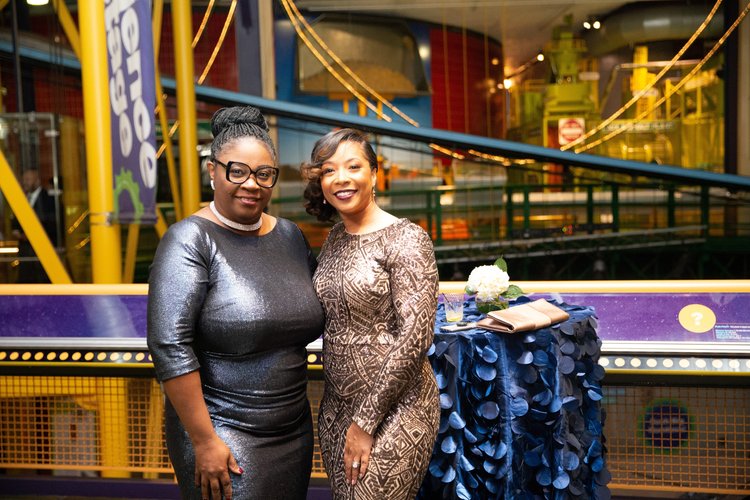
SBN Detroit interviews Dr. E’Lois Thomas, President of SEEL LLC (Solutions for Energy Efficient Logistics), a nationally certified MBE energy program implementation company that serves major utilities throughout the Midwest, South, and Northeast with expansion plans. Here, Thomas shares her thoughts on the correlation between energy resource development and expanding opportunities for disadvantaged minorities. Her leadership has helped SEEL to become one of the largest African American-owned implementation contractors working toward growth in sustainability, energy justice, and equality for all. Thomas is vice chair of the Midwest Energy Efficiency Alliance board, treasurer with Advancing Women in Energy, a member of the American Association of Blacks in Energy board, and a mentor for the Council of Women in Energy and Environmental Leadership. She is a big advocate of youth advancement and volunteers as a board member for RESULTS Mentoring, Detroit Police Athletic League (PAL), and Franklin Wright Settlements. Q: Can you tell me briefly about what work you are doing exactly with SEEL? A: I’ve been with SEEL for 11 years now and with the parent company for more than 20 years, and as president, I guide and oversee all aspects of the company’s operations and growth. Since joining the company, I have worked toward the company’s growth in an industry that is committed to combat the climate crisis. We’ve had to navigate an industry that is rapidly changing from gas and fossil fuels to electrification, renewable, and clean energy. Also, as a leading minority-owned disabled-veteran-owned company, energy access and equity are important to us. We’re intentional about including minorities and underrepresented groups in the conversation. Q: You are involved with the growth trajectory of SEEL – as such what is your vision for the future? A: We’ve been involved in the energy industry since the beginning of broad energy efficiency programs being implemented in communities. The goal then was to reduce the carbon footprint by educating utility customers about energy efficiency and retrofit their homes with energy efficiency products and services. Fast forward to today, the industry is rapidly adopting renewable and clean energy intending to become carbon neutral in the next 25 – 30 years. This provides a great opportunity to grow the company in diverse ways. In addition to offering services related to renewable and clean energy, services like weatherization, building performance, and workforce development all provide rewarding opportunities right now. Q: How will you reach these goals/this vision? A: By continuing to train the workforce of tomorrow, while making an impact on the quality of life of our current employees and the communities we serve. Training is critical, whether it’s training for skilled trades, continuous improvement, building science, energy justice, HVAC, solar, or the training of being an energy-efficiency professional with key attributes like customer service, etc. SEEL is committed to this education. Q: What are some examples of what some local programs SEEL has implemented? A: We are training up our team in renewable energy options like solar and completing pilot projects for community-based organizations and local churches. We are speaking in the community to ensure that electric vehicles include diverse communities by petitioning for inclusion and more charging stations in urban areas. We are collaborating with Detroit 2030 District which continues great work to reduce the environmental impact of buildings and operating costs for building owners/managers in Detroit. In Detroit, we were the first minority-owned corporation to join DTE’s MIGreenPower 100% clean energy at its headquarters. DTE Energy’s MIGreenPower program is among the top three voluntary renewable energy programs in the United States. Notably, MIGreenPower offers simple and affordable renewable energy programs to eligible electric customers, thereby supporting the company’s wind and solar projects. In addition, we are currently reviewing our fleet for fleet emissions reductions with a plan in place to transfer all assets by the end of 2023 to efficiency grade to reduce our carbon footprint. In the state, we also collaborate with Consumers Energy toward their clean energy goals by managing programs with their Clean Energy Plan poised to meet Michigan’s energy needs and to continue the journey to net-zero carbon emissions by 2040, and we implement the entire energy efficiency portfolio for the Upper Peninsula Power Co. (UPPCO), powering through together in one of the most rural, weather-challenged areas in America, and for Indiana Michigan Power as well. Q: What drives your passion? A: I know first-hand the disparities that exist in energy burden. I grew up on the east side of Detroit and graduated from Pershing High School in the Detroit Public Schools Community District. As a young African American student, I always aspired to help others, so what fuels me today is that every customer deserves a path to energy justice, and I have a quest to ensure that this path occurs for everyone, independent of their financial, social or economic status. Not only is energy equity a passion of mine personally and professionally with SEEL, but there is such an opportunity for our industry to impact lives and communities while reaching those that have been underserved for too long. Simply put, access to clean air is a human right, yet so many of us don’t have it. Change is overdue, so the priority is critical now. Q: Outside of SEEL you are involved in many organizations. One is the American Association of Blacks in Energy board. From your perspective, what is the correlation between energy resource development, economic growth, and minorities? A: The correlation between energy resource development, economic growth, and minorities has clearly shown a gap in the representation of minorities that organizations like AABE work to resolve. AABE is a resource for providing information and educating energy consumers from all sectors of society, with emphasis on marginalized communities ensuring that the public and private sectors are responsive to the problems, goals, and aspirations of African Americans. AABE recognizes that access to reliable and affordable energy is essential to everyone so from an inclusion standpoint, we make sure that African Americans are represented in the conversations politically, socially,


